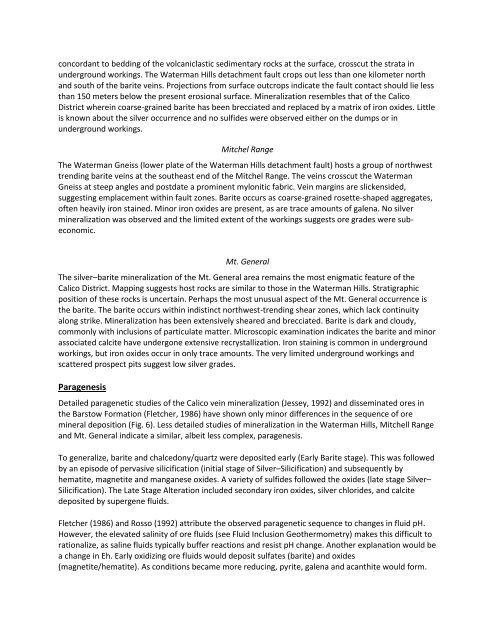Geology and Ore Genesis of Silver–Barite Mineralization in the ...
Geology and Ore Genesis of Silver–Barite Mineralization in the ...
Geology and Ore Genesis of Silver–Barite Mineralization in the ...
Create successful ePaper yourself
Turn your PDF publications into a flip-book with our unique Google optimized e-Paper software.
concordant to bedd<strong>in</strong>g <strong>of</strong> <strong>the</strong> volcaniclastic sedimentary rocks at <strong>the</strong> surface, crosscut <strong>the</strong> strata <strong>in</strong><br />
underground work<strong>in</strong>gs. The Waterman Hills detachment fault crops out less than one kilometer north<br />
<strong>and</strong> south <strong>of</strong> <strong>the</strong> barite ve<strong>in</strong>s. Projections from surface outcrops <strong>in</strong>dicate <strong>the</strong> fault contact should lie less<br />
than 150 meters below <strong>the</strong> present erosional surface. <strong>M<strong>in</strong>eralization</strong> resembles that <strong>of</strong> <strong>the</strong> Calico<br />
District where<strong>in</strong> coarse-gra<strong>in</strong>ed barite has been brecciated <strong>and</strong> replaced by a matrix <strong>of</strong> iron oxides. Little<br />
is known about <strong>the</strong> silver occurrence <strong>and</strong> no sulfides were observed ei<strong>the</strong>r on <strong>the</strong> dumps or <strong>in</strong><br />
underground work<strong>in</strong>gs.<br />
Mitchel Range<br />
The Waterman Gneiss (lower plate <strong>of</strong> <strong>the</strong> Waterman Hills detachment fault) hosts a group <strong>of</strong> northwest<br />
trend<strong>in</strong>g barite ve<strong>in</strong>s at <strong>the</strong> sou<strong>the</strong>ast end <strong>of</strong> <strong>the</strong> Mitchel Range. The ve<strong>in</strong>s crosscut <strong>the</strong> Waterman<br />
Gneiss at steep angles <strong>and</strong> postdate a prom<strong>in</strong>ent mylonitic fabric. Ve<strong>in</strong> marg<strong>in</strong>s are slickensided,<br />
suggest<strong>in</strong>g emplacement with<strong>in</strong> fault zones. Barite occurs as coarse-gra<strong>in</strong>ed rosette-shaped aggregates,<br />
<strong>of</strong>ten heavily iron sta<strong>in</strong>ed. M<strong>in</strong>or iron oxides are present, as are trace amounts <strong>of</strong> galena. No silver<br />
m<strong>in</strong>eralization was observed <strong>and</strong> <strong>the</strong> limited extent <strong>of</strong> <strong>the</strong> work<strong>in</strong>gs suggests ore grades were subeconomic.<br />
Mt. General<br />
The silver–barite m<strong>in</strong>eralization <strong>of</strong> <strong>the</strong> Mt. General area rema<strong>in</strong>s <strong>the</strong> most enigmatic feature <strong>of</strong> <strong>the</strong><br />
Calico District. Mapp<strong>in</strong>g suggests host rocks are similar to those <strong>in</strong> <strong>the</strong> Waterman Hills. Stratigraphic<br />
position <strong>of</strong> <strong>the</strong>se rocks is uncerta<strong>in</strong>. Perhaps <strong>the</strong> most unusual aspect <strong>of</strong> <strong>the</strong> Mt. General occurrence is<br />
<strong>the</strong> barite. The barite occurs with<strong>in</strong> <strong>in</strong>dist<strong>in</strong>ct northwest-trend<strong>in</strong>g shear zones, which lack cont<strong>in</strong>uity<br />
along strike. <strong>M<strong>in</strong>eralization</strong> has been extensively sheared <strong>and</strong> brecciated. Barite is dark <strong>and</strong> cloudy,<br />
commonly with <strong>in</strong>clusions <strong>of</strong> particulate matter. Microscopic exam<strong>in</strong>ation <strong>in</strong>dicates <strong>the</strong> barite <strong>and</strong> m<strong>in</strong>or<br />
associated calcite have undergone extensive recrystallization. Iron sta<strong>in</strong><strong>in</strong>g is common <strong>in</strong> underground<br />
work<strong>in</strong>gs, but iron oxides occur <strong>in</strong> only trace amounts. The very limited underground work<strong>in</strong>gs <strong>and</strong><br />
scattered prospect pits suggest low silver grades.<br />
Paragenesis<br />
Detailed paragenetic studies <strong>of</strong> <strong>the</strong> Calico ve<strong>in</strong> m<strong>in</strong>eralization (Jessey, 1992) <strong>and</strong> dissem<strong>in</strong>ated ores <strong>in</strong><br />
<strong>the</strong> Barstow Formation (Fletcher, 1986) have shown only m<strong>in</strong>or differences <strong>in</strong> <strong>the</strong> sequence <strong>of</strong> ore<br />
m<strong>in</strong>eral deposition (Fig. 6). Less detailed studies <strong>of</strong> m<strong>in</strong>eralization <strong>in</strong> <strong>the</strong> Waterman Hills, Mitchell Range<br />
<strong>and</strong> Mt. General <strong>in</strong>dicate a similar, albeit less complex, paragenesis.<br />
To generalize, barite <strong>and</strong> chalcedony/quartz were deposited early (Early Barite stage). This was followed<br />
by an episode <strong>of</strong> pervasive silicification (<strong>in</strong>itial stage <strong>of</strong> Silver–Silicification) <strong>and</strong> subsequently by<br />
hematite, magnetite <strong>and</strong> manganese oxides. A variety <strong>of</strong> sulfides followed <strong>the</strong> oxides (late stage Silver–<br />
Silicification). The Late Stage Alteration <strong>in</strong>cluded secondary iron oxides, silver chlorides, <strong>and</strong> calcite<br />
deposited by supergene fluids.<br />
Fletcher (1986) <strong>and</strong> Rosso (1992) attribute <strong>the</strong> observed paragenetic sequence to changes <strong>in</strong> fluid pH.<br />
However, <strong>the</strong> elevated sal<strong>in</strong>ity <strong>of</strong> ore fluids (see Fluid Inclusion Geo<strong>the</strong>rmometry) makes this difficult to<br />
rationalize, as sal<strong>in</strong>e fluids typically buffer reactions <strong>and</strong> resist pH change. Ano<strong>the</strong>r explanation would be<br />
a change <strong>in</strong> Eh. Early oxidiz<strong>in</strong>g ore fluids would deposit sulfates (barite) <strong>and</strong> oxides<br />
(magnetite/hematite). As conditions became more reduc<strong>in</strong>g, pyrite, galena <strong>and</strong> acanthite would form.

















